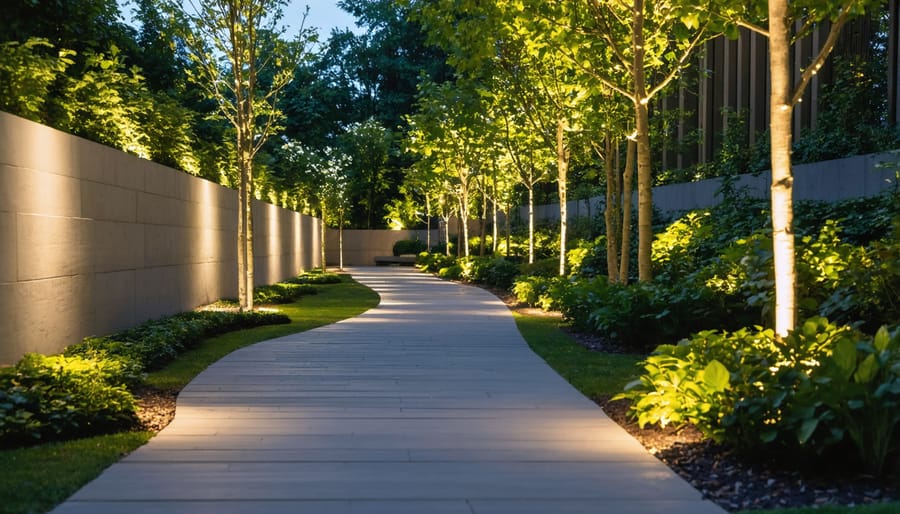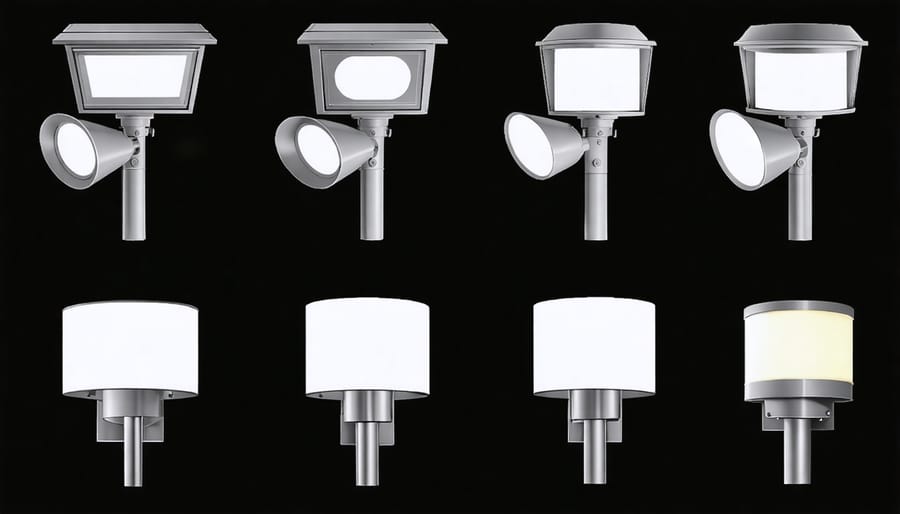Transform any outdoor space into a captivating nighttime retreat by mastering the art of illumination design. Just as you can transform your home’s atmosphere indoors, strategic outdoor lighting creates depth, security, and ambiance in your exterior spaces.
Layer your lighting with three essential elements: ambient illumination for overall visibility, task lighting for functional areas like pathways and entrances, and accent lighting to highlight architectural features and landscaping. Start by mapping your space’s traffic patterns and focal points, then position fixtures to guide movement naturally while creating visual interest.
Modern LED technology offers unprecedented control over color temperature and intensity, allowing you to craft different moods for various occasions. Choose warm white lights (2700-3000K) for intimate gathering spaces, and cooler tones (3000-4000K) for security areas. Install smart controls to automate your lighting based on time, motion, or weather conditions, maximizing both efficiency and convenience.
Remember: effective outdoor lighting design balances beauty with functionality, creating spaces that are both welcoming and secure throughout the evening hours.
Planning Your Outdoor Lighting Strategy
Understanding Light Zones
When planning your outdoor lighting, it’s helpful to think of your space in distinct zones, each serving a unique purpose. Your entryway zone needs bright, welcoming illumination for safety and greeting guests. Pathways and walkways form another crucial zone requiring consistent, low-level lighting to guide movement after dark.
Entertainment areas like patios and decks benefit from layered lighting – combining ambient overhead lights with accent fixtures to create the right mood for gatherings. Garden zones call for subtle illumination that highlights special features while respecting the natural nighttime environment.
Functional zones like driveways and garage areas need clear, practical lighting for vehicle and pedestrian safety. Don’t forget about security zones – dark corners and property boundaries that benefit from motion-sensor lights or strategic permanent fixtures.
Consider how these zones interact with each other and adjust brightness levels accordingly. For example, transition areas between brightly lit entertainment spaces and darker garden zones need graduated lighting to help eyes adjust comfortably. Remember, successful outdoor lighting creates harmony between these different zones while serving each area’s specific needs.
Creating a Lighting Plan
Creating a successful outdoor lighting plan starts with a methodical approach that builds on natural lighting principles. Begin by walking your property during both day and night to identify key areas that need illumination. Grab a piece of paper and sketch your outdoor space, marking important features like pathways, entry points, gardens, and architectural elements.
Next, determine your lighting goals for each area. Do you need bright, functional lighting for safety near steps, or subtle accent lighting to highlight your favorite garden features? Make notes about the purpose of each lighting zone – security, ambiance, or functionality.
Consider these practical steps:
1. Map out traffic patterns and identify potential hazards
2. List architectural features you want to highlight
3. Note existing electrical outlets and power sources
4. Mark areas that need task lighting (grilling spaces, outdoor kitchens)
5. Identify spots for ambient lighting
6. Plan for seasonal changes in natural light
Remember to think about light layering – combining different types of lighting to create depth and functionality. Start with essential safety lighting, then add accent and decorative elements. Don’t forget to consider your neighbors and local light pollution guidelines when planning fixture placement and intensity.
By taking time to create a detailed lighting plan, you’ll avoid common pitfalls and create an outdoor space that’s both beautiful and functional throughout the year.
Essential Lighting Techniques
Uplighting and Downlighting
When it comes to adding depth and drama to your outdoor spaces, uplighting and downlighting are two powerful techniques that can help you create a cozy outdoor atmosphere while highlighting your property’s best features.
Uplighting involves placing fixtures at ground level and directing light upward, creating dramatic shadows and emphasizing vertical elements. This technique works beautifully for showcasing tall trees, architectural columns, and textured walls. To achieve the best results, position lights about 12 inches from the base of your focal point and experiment with different angles until you find the perfect dramatic effect.
Downlighting, also known as moonlighting, mimics natural light patterns by mounting fixtures in elevated positions and directing light downward. This creates gentle, diffused illumination that feels organic and welcoming. Try installing lights in trees to cast beautiful dappled shadows on pathways, or mount them under eaves to softly illuminate gathering spaces.
For maximum impact, combine both techniques in your outdoor lighting design. Use uplighting to highlight statement features like mature trees or decorative stonework, while implementing downlighting to provide practical illumination for seating areas and walkways. The key is finding the right balance – you want enough light to create atmosphere without overwhelming the space.
Pro tip: Install dimmers for both uplight and downlight fixtures. This allows you to adjust the intensity based on the occasion and time of day, ensuring your outdoor space always has the perfect ambiance.

Path and Feature Lighting
Path and feature lighting serves as your landscape’s nighttime tour guide, creating both safety and visual interest throughout your outdoor space. Start by identifying the main walkways and focal points that deserve attention – these might include your front path, garden trails, or that beautiful Japanese maple you’d love to showcase after dark.
For pathways, consider mounting lights at regular intervals, typically 6-8 feet apart, to ensure consistent illumination without creating a “runway” effect. Low-voltage path lights are perfect for this purpose, casting gentle pools of light that guide the way without overwhelming the space. Pro tip: stagger the lights on alternate sides of wider paths to create a more natural, flowing appearance.
When it comes to feature lighting, think about highlighting your yard’s star attractions. Up-lighting techniques work wonderfully for trees and architectural elements, creating dramatic shadows and depth. For smaller features like statues or water features, consider cross-lighting using two fixtures from different angles to eliminate harsh shadows and create a more three-dimensional effect.
Remember to layer your lighting for the best results. Combine different techniques like grazing (placing lights close to textured surfaces), silhouetting (lighting behind objects), and wash lighting (broad, even illumination) to create depth and interest. Start with essential pathway lighting for safety, then add feature lighting elements one by one until you achieve the perfect balance.
Choose fixtures that complement your home’s style while remaining discreet during daylight hours. Copper and bronze finishes age beautifully outdoors, while black fixtures tend to disappear into the landscape.
Choosing the Right Fixtures

Types of Outdoor Lights
When it comes to outdoor lighting, choosing the right fixtures can make all the difference in creating your perfect outdoor space. Let’s explore the most popular types and their ideal applications.
Path lights are perfect for illuminating walkways and garden borders. These low-profile fixtures cast a gentle downward glow, ensuring safe navigation while adding a welcoming touch to your landscape.
For dramatic effect, uplights are your go-to choice. These ground-mounted fixtures shine upward, perfect for highlighting architectural features, trees, or artwork. They create stunning shadows and depth, especially when positioned at different angles.
Wall-mounted sconces serve both practical and aesthetic purposes. They’re ideal for entryways, garage doors, and patios, providing essential visibility while complementing your home’s architectural style.
Post lights stand tall as statement pieces, perfect for driveways, property boundaries, or anchoring larger landscape designs. Choose styles that match your home’s character while providing adequate illumination.
Step lights are essential for safety, especially on stairs and level changes. These compact fixtures can be recessed into walls or risers, offering subtle but effective illumination without being visually intrusive.
String lights add a magical touch to entertaining spaces. Whether draped across a patio or wrapped around trees, they create an inviting ambiance perfect for outdoor gatherings.
Finally, security lights with motion sensors provide peace of mind while being energy efficient. Position these brighter fixtures strategically around entry points and darker corners of your property.
Material and Durability Considerations
When selecting outdoor lighting fixtures, durability is just as important as aesthetics. Start with materials specifically designed to withstand the elements. Look for fixtures labeled with an IP (Ingress Protection) rating of at least IP65, which ensures protection against both dust and water jets from any direction.
Marine-grade stainless steel and solid brass are excellent choices for coastal areas where salt air can be particularly corrosive. These materials develop an attractive patina over time while maintaining their structural integrity. For more budget-friendly options, powder-coated aluminum offers good durability and comes in various finishes.
Consider your local climate when choosing materials. In areas with frequent rainfall, opt for fixtures with sealed seams and waterproof gaskets. For regions with intense sun exposure, UV-resistant materials and finishes prevent fading and deterioration. Cold-climate dwellers should select fixtures rated for extreme temperatures to prevent cracking.
Don’t forget about the electrical components. Choose fixtures with weather-resistant wiring and sealed connections. LED lights are particularly well-suited for outdoor use, as they’re more resilient than traditional bulbs and require less maintenance.
Regular maintenance will extend the life of your outdoor lighting. Clean fixtures seasonally, check seals annually, and replace any damaged components promptly. A little preventive care goes a long way in ensuring your outdoor lighting remains beautiful and functional for years to come.
Smart Integration and Control
Automation Systems
Modern outdoor lighting has evolved far beyond simple manual switches, thanks to innovative automation systems that make managing your outdoor illumination effortless and efficient. Today’s smart controls offer unprecedented convenience and flexibility in how you light up your outdoor spaces.
Motion sensors are a game-changer for security and convenience, automatically illuminating pathways and entry points when movement is detected. These sensors can be adjusted for sensitivity and range, ensuring they respond only when needed. For added peace of mind, you can integrate them with security cameras and smartphone notifications.
Programmable timers have also become more sophisticated, allowing you to create custom schedules that mirror your lifestyle. Set your lights to turn on at sunset and off at sunrise, or create specific time windows for different zones in your yard. Many systems even adjust automatically to seasonal changes in daylight hours.
Smart home integration takes automation to the next level, offering voice control and app-based management of your outdoor lighting. Through eco-tech smart integration, you can group lights into zones, adjust brightness levels, and even change colors for LED fixtures – all from your smartphone.
Weather-responsive controls are another brilliant feature, automatically adjusting your lighting based on environmental conditions. These systems can dim lights on bright moonlit nights or increase brightness during foggy conditions, optimizing both visibility and energy efficiency.
To get started with automation, consider beginning with a basic smart controller and gradually expanding your system. Many platforms are modular, allowing you to add features and zones as your needs evolve. Remember to choose weather-resistant components specifically rated for outdoor use to ensure long-term reliability.

Energy Efficiency and Maintenance
Making your outdoor lighting both energy-efficient and easy to maintain doesn’t have to be complicated. As part of your sustainable outdoor design, start by choosing LED fixtures, which use up to 75% less energy than traditional bulbs and can last up to 25 times longer. Installing motion sensors and timers helps reduce unnecessary energy usage while ensuring your lights work only when needed.
Consider solar-powered lights for areas that receive plenty of sunlight during the day. These fixtures are self-sufficient and require minimal maintenance beyond occasional cleaning. For optimal performance, position solar panels where they’ll receive maximum sun exposure and clean them every few months to remove dust and debris.
Regular maintenance is key to extending the life of your outdoor lighting system. Create a seasonal checklist that includes:
– Checking and tightening loose connections
– Cleaning fixture lenses and housing
– Trimming vegetation around lights
– Inspecting wiring for wear or damage
– Testing motion sensors and timers
During installation, use weatherproof fixtures and connections to prevent moisture damage. Consider installing a smart lighting system that allows you to monitor energy usage and control your lights remotely. This not only adds convenience but helps you optimize power consumption based on actual usage patterns.
Remember to keep spare bulbs and parts on hand for quick replacements, and always document your lighting layout for easier troubleshooting in the future.
Creating the perfect outdoor lighting design is an exciting journey that can transform your outdoor spaces into magical nighttime retreats. By following the principles and guidelines we’ve discussed, you can create a lighting scheme that enhances both the beauty and functionality of your property while ensuring safety and energy efficiency.
Remember to start with a comprehensive plan that considers your specific needs, from security lighting to accent features. Choose fixtures that complement your home’s architecture and integrate smart technology where it makes sense for your lifestyle. Don’t forget to layer your lighting, combining ambient, task, and accent lighting to create depth and visual interest.
As you embark on your outdoor lighting project, take time to experiment with different arrangements and lighting levels. Start small if you’re feeling overwhelmed – you can always add more fixtures later. Consider working with seasonal changes by adjusting your lighting schedule and intensity throughout the year.
Whether you’re illuminating a cozy patio, creating a welcoming entrance, or highlighting your garden’s best features, thoughtful outdoor lighting design can dramatically improve your home’s curb appeal and extend your living space into the evening hours.
Ready to get started? Begin by assessing your outdoor areas and making a simple sketch of where you’d like to add lighting. With careful planning and the right fixtures, you’ll soon be enjoying your beautifully illuminated outdoor sanctuary.
